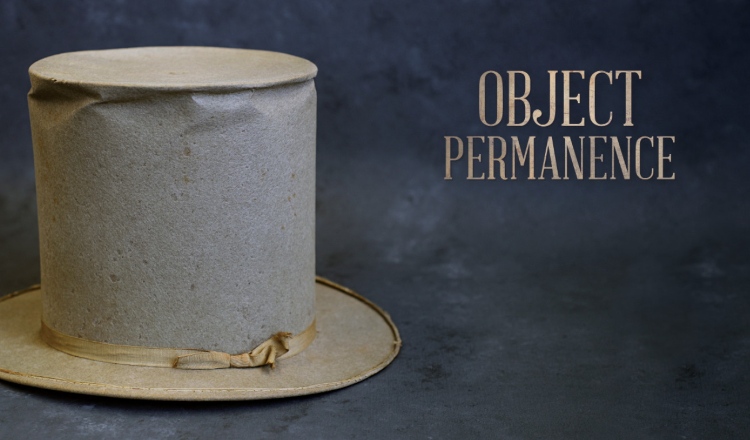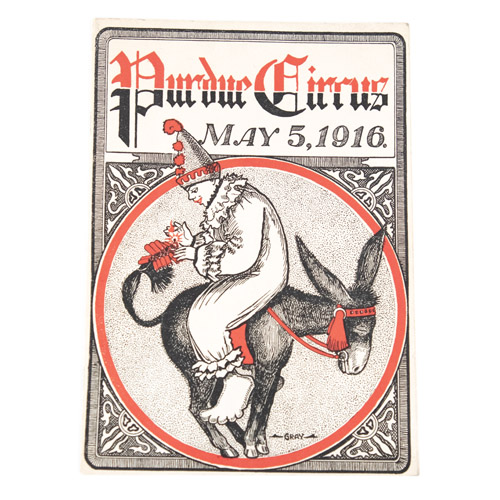
101. Purdue Circus Program
The first Purdue Circus was held on Stuart Field in May 1913. Forty organizations made floats and marched through the streets of Lafayette before the evening performance; about 300 students performed. Because the circus was a big success, it was continued on a larger scale in 1914. The circus continued with success in 1915 and 1916, but the entry of the United States into World War I stopped the circus until 1921, when it made a brief reappearance before discontinuation in 1923.
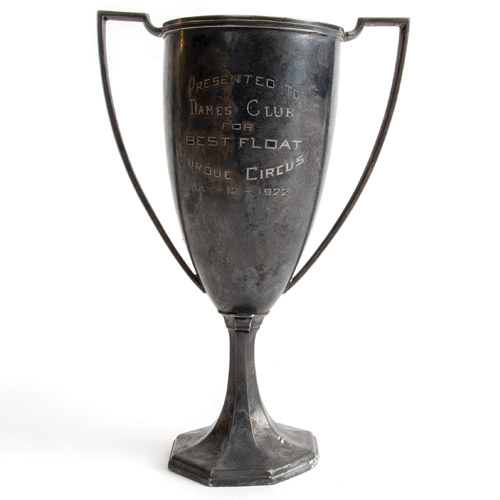
102. Purdue Circus Trophy
This cup was presented to the Dames Club for best float at the Purdue Circus in 1922. The tradition of university dames clubs began at Harvard in 1896. The club was devoted to creating a sense of community among the wives of students as well as a source of social and intellectual development and philanthropic endeavors. The women could elect to participate in special-interest groups organized through the Dames, such as bridge, sports, and child development. The Purdue Dames were well-known for their annual fashion show and craft bazaar. Dean Carolyn Shoemaker (S’1888, MS S’1889) was a founding member and sponsor of the Dames from their inception in 1918. Shoemaker remained a strong supporter of and advocate for University Dames until her death in 1933.
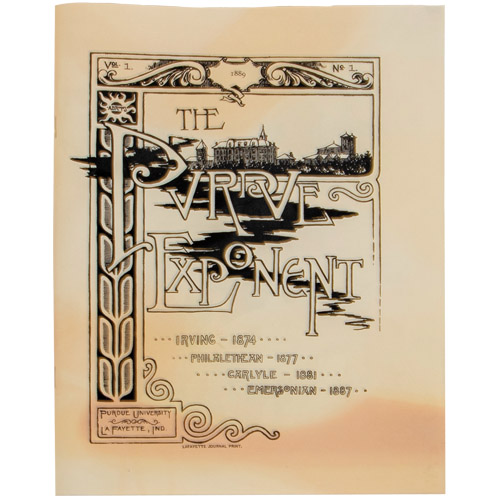
103. ‘Purdue Exponent’ First Edition
The original student newspaper of the 1870s, the Purdue, had a short life but was revived in the fall of 1882, a combined effort of the Irving, Philalethean, and Carlyle literary societies. The content involved short literary, scientific, and engineering pieces; poems; and campus news. The publication continued until the spring of 1888, when tensions between the faculty and student staff led to its demise. The Purdue Exponent followed in December 1889 as a monthly publication with A. Eugenia Vater (S’81), editor-in-chief. The issue included an entry on soup that opened, “Soup is generally considered as a great luxury. There is nothing so appropriate with which to begin a meal. Mrs. Ewing, formerly instructor in Domestic Economy, said that it would be well if every meal was begun with soup, as it takes off the sharp edge of the appetite.”
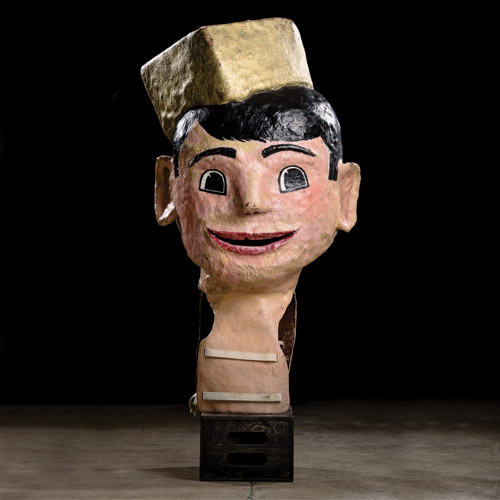
104. Purdue Pete Head
Purdue Pete’s look has changed a lot since the school’s first human mascot, Larry Burmbaugh (ME’57), ran onto the field during a pep rally on September 28, 1956. This bulky fiberglass rendition with the jaunty square cap, described as more harness than head, existed in some form from 1963 to 1980. Former Petes claim the cumbersome getup, designed more for image than comfort, limited movement and weighed anywhere from 47 to 65 pounds.
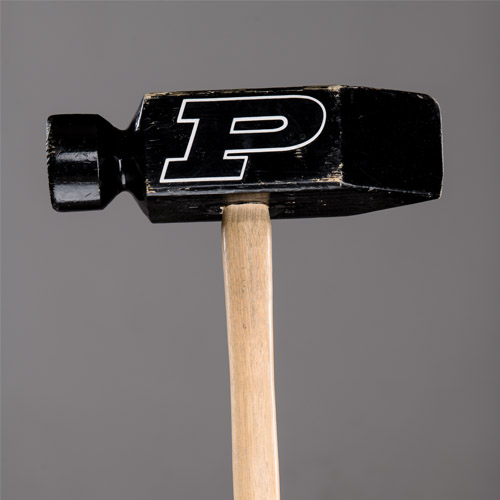
105. Purdue Pete’s Hammer
Purdue Pete’s hammer, reminiscent of the type of large mallets used to mold steel, is meant to represent the strength, power, and determination required to be a Boilermaker.
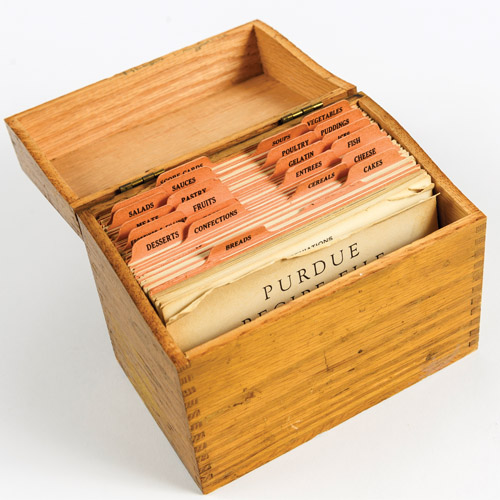
Courtesy of the Virginia Kelly Karnes Archives and Special Collections Research Center, Purdue University Libraries
106. Purdue Recipe File
Amy Irene Bloye came to Purdue as a home economics instructor in 1918 and was later made head of the Department of Foods and Nutrition, today the Department of Nutrition Science, holding that position until 1953. Bloye established the first dietetics program in Indiana at Purdue in 1923. Bloye also created the famous Purdue Recipe File, an oak box with a hinged lid and intricate joinery that housed the collection of 400 recipes used by students in the School of Home Economics. The recipes were printed on four-by-six-inch cards and divided among 24 subjects from breads to vegetables. The file was copyrighted by Bloye in 1927 and revised in 1936. The Purdue Recipe File could be purchased at Southworth’s Bookstore in West Lafayette.
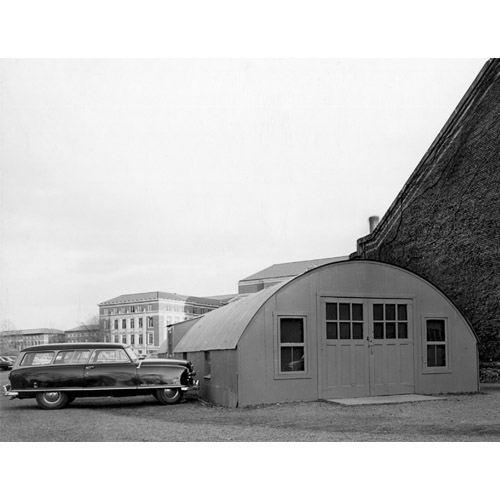
107. Quonset Hut
Intended to be temporary structures for classes after the post-World War II boom in attendance, Quonset huts became a familiar sight for generations of Purdue students. The Exponent poked fun at the tiny structures as far back as 1946:
“In each petite hut the classrooms two,
Resemble the monkey house at the Columbian Park Zoo…
Classes in the Quonset huts are open to all,
Provided you are not over five feet tall.”
Although the last true Quonset hut — a sort of small-scale airplane hangar with arching roof — on central campus was demolished in 1969, the term was adopted to describe all similar stopgap buildings dating from that time. The last cluster of temporary barracks from the era remained on campus until 2004 when four structures — then housing art, design, and theater classes — were razed to make way for the Armstrong Hall of Engineering at Stadium and Northwestern Avenues.
The last of the WWII temporary buildings were demolished in 2004.
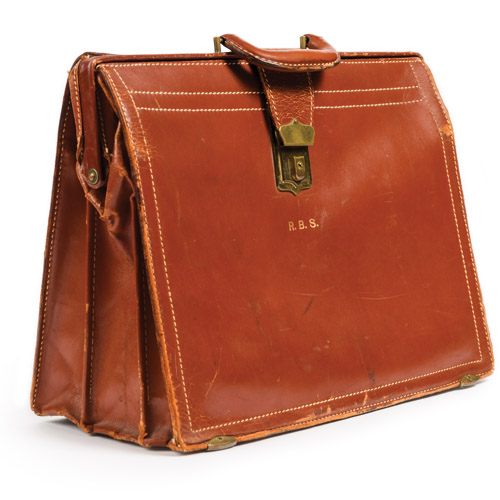
Courtesy of the Virginia Kelly Karnes Archives and Special Collections Research Center, Purdue University Libraries
108. R. B. Stewart’s Briefcase
When R.B. Stewart arrived on campus as controller in 1925, enrollment was 3,000 students; the physical plant was worth $3 million; and the endowment totaled $340,000. Upon his retirement as vice president and treasurer in 1961, enrollment had grown to 22,000; the physical plant was valued at $160 million; and yields from the $25 million endowment were producing funds for research, scholarships, and grants. One of the University’s most influential administrators, Stewart had a domineering and formidable personality. A colleague once said, “He was an interesting person to work for, but it was much better if your ideas and his coincided.”
Stewart Center is named for R.B. Stewart.
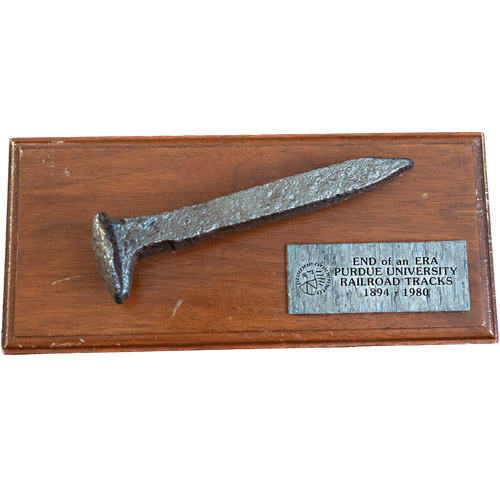
109. Railroad Spike
Students from 1894 to 1980 were all familiar with the locomotive and its coal car that trudged from south campus by Smith Hall and crossed State Street by the Home Economics Building (Matthews Hall) on its way to the power plant. This vital lifeline kept the boilers that supported campus buildings functioning every day — in rain, snow, or wind. There is likely no student who attended Purdue during that time who wasn’t temporarily halted walking to class or blocked driving along State Street by the locomotive and its coal car. With the shifting of the University’s power source to the south campus facilities, the central power plant was shut down, and the need for the coal, coal car, and railroad track ended. This spike commemorates the decades of service — and occasional inconvenience — these tracks represented.
Rush Crossing pays homage to the railroad tracks that once cut through campus.
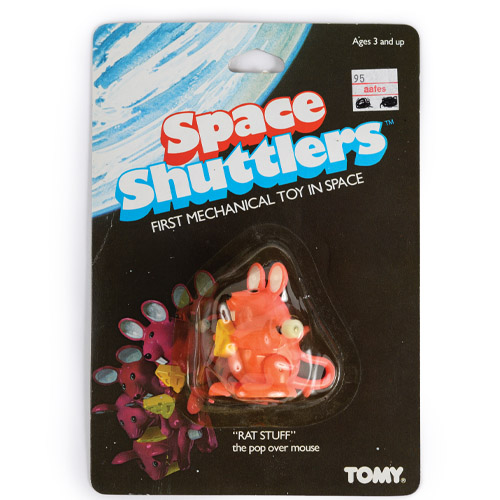
Courtesy of the Virginia Kelly Karnes Archives and Special Collections Research Center, Purdue University Libraries
110. The Rat Stuff
Astronauts Gregory Harbaugh (AAE’78) and John Casper (MS AAE’67) were among the crew members testing how mechanical toys reacted to the weightlessness of space during a shuttle experiment on STS-54. A mechanical mouse showed unearthly energy in orbit, flipping over rapidly and often in the virtual absence of gravity. The astronauts nicknamed it the Rat Stuff, which led to mass production of a pop-over mouse marketed as the first mechanical toy in space.

